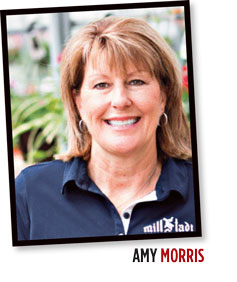10/1/2022
The Dump Pile: What’s in Yours?
Amy Morris

Early sales of our fall crops have shown that we’re going to have a strong and successful fall as long as our weather cooperates. This is a nice and needed change from our spring crop, where weather shut us down on all shipping. But is this a false hope that things are getting better? And will the market allow us to stay part of the latest trend we’ve shared the last two years? These questions are on everyone’s mind and it’s up to us to make the changes we need for the good of the company.
As I talked about in my last article, our company had to take a long and hard look at what we were producing and whether it was the quality that all our customers deserve. Next, we took a long, hard look at our dump pile and asked ourselves, “Why is it there?” What was the cause of these unsaleable plants? Was it due to a growing problem? Did the weather cause this problem? Or was it saleable plants that simply couldn’t be shipped due to the weather shutdown?
Nothing hurts more than having good- quality plants ready to ship and you end up dumping them due to market shutdown. This isn’t only hard on the company; it’s also very discouraging for the grower who put all his time and effort in these crops and they still get dumped. The dump pile affects everyone and needs to be looked at.
Breaking down the dump pile is a good practice and I encourage all growers to do so. We all know we have a pile, but do we all know what’s in it? Do we understand the percentage of plants that were dumped due to insects, disease, overgrowth, over- or under-speculation and product that didn’t go to market due to lack of sales? After last spring, not only do we need to take a good long look at our future forecast and adjust numbers, but we also need to look at the dump pile to filter out what was dumped and why it was dumped to fine-tune our production next year.
Many companies do inventory, and part of this process is to keep the correct numbers of all product for sales to have a good availability for them to sell. But most of the time, the starting number can change to the saleable number. How is it being recorded and are you using that information to change your plan for future sales?
At Heimos, we have an inventory system that allows us to record dumps, along with the cause of the dump, whether it’s poor quality due to untimely PGR applications, disease or insects, past its prime, physical damage, changed planter or step-up, unaccountable planting line discrepancy or end-of-season dump. This is where the sales team makes the major adjustments for future sales. But it’s so important for the production team to look at what’s causing the dump and make changes that will keep inventory out of the pile.
The inventory dumps you want to look at the closest are poor quality due to PGR, disease or insect, and physical damage. These two areas are where the biggest growing improvement can be made. It can be anything from transplanting poor-quality cuttings, over-rooted due to the planting line getting behind, overwatering, letting the plant dry down, not scouting or applying PGRs on time.
This is where communication is vital to your company’s success. Making sure both teams are aware of problems as early as possible help correct issues sooner rather than later.
Also, if you’re struggling with a crop year after year, get rid of it and find a good sub you can grow. Most buyers are good if you let them know ahead of time and you offer a suitable sub. Lastly, make sure you’re keeping records of PGR spray successes and failures. Most often, time will repeat itself and it’ll guide you in your future crops.
Physical damage can be both an act of nature or spraying error. As you know, there’s nothing you can do about the hail storm that hit May 1 and put holes in your entire outdoor production. Or you have wash-out due to storms. But you can look at what you had to dump due to spray damage, and what and why it happened. Many times, damage is caused from dry plants being sprayed on a hot day or spray sitting on the crop too long on a cold, cloudy day. The lesson to take from this is don’t spray until you walk all of your crops and make sure your rates and spray nozzle are adjusted correctly. Keep good air movement after you spray and record any problems so you don’t make the same mistake twice.
Getting to know your dump pile is a very critical part of your business, and the more adjustments you can make to keep inventory out of the dump, the healthier your company will be. GT
Amy Morris is Vice President of N.G. Heimos Greenhouses in Millstadt, Illinois. She can be reached at Amorris@ngheimos.com.